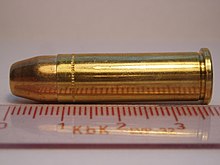.38 Special
| .38 Special | ||||||||||||||||||||||||
|---|---|---|---|---|---|---|---|---|---|---|---|---|---|---|---|---|---|---|---|---|---|---|---|---|

.38 Special round, scale in centimeters
|
||||||||||||||||||||||||
| Type | Revolver | |||||||||||||||||||||||
| Place of origin | ||||||||||||||||||||||||
| Production history | ||||||||||||||||||||||||
| Designer | Smith & Wesson | |||||||||||||||||||||||
| Specifications | ||||||||||||||||||||||||
| Parent case | .38 Long Colt | |||||||||||||||||||||||
| Case type | Rimmed, straight | |||||||||||||||||||||||
| Bullet diameter | .357 in (9.1 mm) | |||||||||||||||||||||||
| Neck diameter | .379 in (9.6 mm) | |||||||||||||||||||||||
| Base diameter | .379 in (9.6 mm) | |||||||||||||||||||||||
| Rim diameter | .44 in (11 mm) | |||||||||||||||||||||||
| Rim thickness | .058 in (1.5 mm) | |||||||||||||||||||||||
| Case length | 1.155 in (29.3 mm) | |||||||||||||||||||||||
| Overall length | 1.55 in (39 mm) | |||||||||||||||||||||||
| Primer type | Small revolver | |||||||||||||||||||||||
| Ballistic performance | ||||||||||||||||||||||||
|
||||||||||||||||||||||||
|
Test barrel length: 4 in (vented) Source(s): |
||||||||||||||||||||||||
The .38 Smith & Wesson Special (commonly .38 Special, .38 Spl, or .38 Spc, pronounced "thirty-eight special") is a rimmed, centerfire cartridge designed by Smith & Wesson. It is most commonly used in revolvers, although some semi-automatic pistols and carbines also use this round. The .38 Special was the standard service cartridge of most police departments in the United States from the 1920s to the early 1990s, and was also a common sidearm cartridge used by soldiers in World War I. In other parts of the world, it is known by its metric designation of 9×29.5mmR or 9.1×29mmR.
Noted for its accuracy and manageable recoil, the .38 Special remains the most popular revolver cartridge in the world more than a century after its introduction. It is used for target shooting, formal target competition, personal defense, and for hunting small game.
Despite its name, the caliber of the .38 Special cartridge is actually .357–.358 inches (9.0678 mm), with the ".38" referring to the approximate diameter of the loaded brass case. This came about because the original .38-caliber cartridge, the .38 Short Colt, was designed for use in converted .36-caliber cap-and-ball (muzzleloading) Navy revolvers, which had cylindrical firing chambers of approximately 0.374-inch (9.5 mm) diameter, requiring heeled bullets, the exposed portion of which was the same diameter as the cartridge case.
Except for case length, the .38 Special is identical to the .38 Short Colt, .38 Long Colt, and .357 Magnum. This allows the .38 Special round to be safely fired in revolvers chambered for the .357 Magnum, and the .38 Long Colt in revolvers chambered for .38 Special, increasing the versatility of this cartridge. However, the longer and more powerful .357 Magnum cartridge will usually not chamber and fire in weapons rated specifically for .38 Special (e.g. all versions of the Smith & Wesson Model 10), which are not designed for the greatly increased pressure of the magnum rounds. Both .38 Special and .357 Magnum will chamber in Colt New Army revolvers in .38 Long Colt, due to the straight walled chambers, but this should not be done under any circumstances, due to dangerous pressure levels, up to three times what the New Army is designed to withstand.
...
Wikipedia
